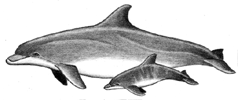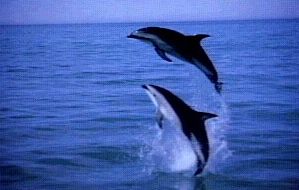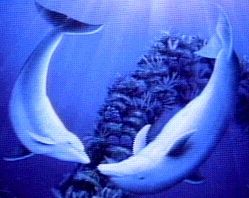



 Dolphins are small, toothed whales that belong to the Family Delphinidae under the Suborder Odontoceti and Order Cetacea.
Dolphins are small, toothed whales that belong to the Family Delphinidae under the Suborder Odontoceti and Order Cetacea.
 The old Greek name Dolphin, used to designate these small, toothed whales, conveys a feeling of light and grace. In deed, their beauty, their swift speed in the water, the keen and fiery light they flash from their eyes, make the dolphins the most admired, the most loved sea mammals.
The old Greek name Dolphin, used to designate these small, toothed whales, conveys a feeling of light and grace. In deed, their beauty, their swift speed in the water, the keen and fiery light they flash from their eyes, make the dolphins the most admired, the most loved sea mammals.

 Dolphins have a sleek streamlined fusiform body. They are tight-skinned and feel rubbery to the touch.
Dolphins have a sleek streamlined fusiform body. They are tight-skinned and feel rubbery to the touch. 
 The average length of a dolphin is about 7 1/2 feet long.
The average length of a dolphin is about 7 1/2 feet long.
 Dolphins can be distinguished from the smaller porpoises by the shape of the head. The dolphin's head is lengthened by a narrow "beak', while the porpoise's face is blunter.
Dolphins can be distinguished from the smaller porpoises by the shape of the head. The dolphin's head is lengthened by a narrow "beak', while the porpoise's face is blunter.
 In the body of a dolphin, traces of hind limbs have disappeared, except for two reduced, rod shaped pelvic bones, which are buried deep in body muscle.
In the body of a dolphin, traces of hind limbs have disappeared, except for two reduced, rod shaped pelvic bones, which are buried deep in body muscle.
 Like the flukes, the dorsal fin is made of dense, fibrous connective tissue, with no bones. The dorsal fin acts as a keel, stablilizing a dolphin as it swims. As in the flukes and the flippers, arteries in the dorsal fin are surrounded by veins to help conserve body heat in cold water.
Like the flukes, the dorsal fin is made of dense, fibrous connective tissue, with no bones. The dorsal fin acts as a keel, stablilizing a dolphin as it swims. As in the flukes and the flippers, arteries in the dorsal fin are surrounded by veins to help conserve body heat in cold water.

Dolphins like to live in the warmer and tropical waters of the world, only a few species venturing into the temperate and polar regions.
 Common Dolphin: found worldwide but prefers warmer regions of the Pacific, Atlantic and Indian Oceans and the Mediterranean and Black Seas. They always try to avoid the cold polar regions.
Common Dolphin: found worldwide but prefers warmer regions of the Pacific, Atlantic and Indian Oceans and the Mediterranean and Black Seas. They always try to avoid the cold polar regions.
 Bottlenose Dolphin: in the Pacific Ocean, they are found from northern Japan and California to Australia and Chile. In the Atlantic Ocean, they're found from Nova Scotia and Norway to Patagonia and the tip of south Africa.
Bottlenose Dolphin: in the Pacific Ocean, they are found from northern Japan and California to Australia and Chile. In the Atlantic Ocean, they're found from Nova Scotia and Norway to Patagonia and the tip of south Africa.
 Spotted Dolphin: found in open sea from Mexico, north into southern California.
Spotted Dolphin: found in open sea from Mexico, north into southern California.
 Northern Right-Whale Dolphin: found from southern California north to Alaska.
Northern Right-Whale Dolphin: found from southern California north to Alaska.
 Pacific White-sided Dolphin: a common deep-sea West Coast species from Panama to Alaska, usually in fairly large schools that migrate with the fish they chase.
Pacific White-sided Dolphin: a common deep-sea West Coast species from Panama to Alaska, usually in fairly large schools that migrate with the fish they chase.

Life spans for cetacean species are estimated from about 30 years in the smaller Odontocetes. Bottlenose dolphins have lived as long as 40 years.

 The dolphin is a highly vocal creature and a lot of studies have been done on all aspects of its way of communication by sound. Dolphins do indeed "speak" to each other. Results from recent studies have shown that they are capable of uttering and receiving all manner of instructions and communications.
The dolphin is a highly vocal creature and a lot of studies have been done on all aspects of its way of communication by sound. Dolphins do indeed "speak" to each other. Results from recent studies have shown that they are capable of uttering and receiving all manner of instructions and communications.
 The commonest dolphin sound is a whistling one, in varying intensities, for displaying emotions such as fear, excitement and anticipation.
The commonest dolphin sound is a whistling one, in varying intensities, for displaying emotions such as fear, excitement and anticipation.
Here are some examples of the sound of:
 Wild Bottlenose Dolphin from the Moray Firth, Scotland.
Wild Bottlenose Dolphin from the Moray Firth, Scotland.
 Sharky's signature whistle
Sharky's signature whistle

 Dolphins are active predators. They eat wide variety of fishes, molluscs such as squids , but will also consume many other small animals, mainlly crustaceans such as shrimps. The foods available to a dolphin vary with its geographic location.
Dolphins are active predators. They eat wide variety of fishes, molluscs such as squids , but will also consume many other small animals, mainlly crustaceans such as shrimps. The foods available to a dolphin vary with its geographic location.

 Dolphins in a group appear to establish strong social bonds. Behavior studies suggest that dolphins prefer association with each other and recognize each other after periods of separation. Field observations suggest that mother-calf bonds are long-lasting in dolphin group.
Dolphins in a group appear to establish strong social bonds. Behavior studies suggest that dolphins prefer association with each other and recognize each other after periods of separation. Field observations suggest that mother-calf bonds are long-lasting in dolphin group. 
 During mating, dolphins may scratch one another with their teeth, leaving superficial lacerations which soon heal. Traces of light parallel stripes remain on the skin of the dolphin.
During mating, dolphins may scratch one another with their teeth, leaving superficial lacerations which soon heal. Traces of light parallel stripes remain on the skin of the dolphin.
 Dolphin courtship behavior includes twisting, nuzzling, and tooth-scratching.
Dolphin courtship behavior includes twisting, nuzzling, and tooth-scratching.







![[*]](dot-2.gif) CSULA Library (login as Library) and Melvyl (you will need to identify your terminal) for books.
CSULA Library (login as Library) and Melvyl (you will need to identify your terminal) for books.
![[*]](dot-2.gif) CARL (you will need to identify your terminal) for articles.
CARL (you will need to identify your terminal) for articles.![[*]](dot-2.gif) SEA WORLD/BUSCH GARDENS
SEA WORLD/BUSCH GARDENS
![[*]](dot-2.gif) Recreation: Animals, Insects, and Pets
Recreation: Animals, Insects, and Pets
The following has been added by the Electronic Desktop Project:
 Contact Us
Contact UsIf you are an educator who is using our NEXTSTEP or virtual applications in the classroom, we would especially like to hear from you. Let us know what you are doing and how it is working out. Continued support for this project will depend on its impact in science education.
If you are an educator who is interested in making use of our NEXTSTEP or virtual applications, please let us know how we can help.
 Return to the Electronic Desktop Project home page
Return to the Electronic Desktop Project home page
![]() Check out the WWW Virtual Application Catalog from the EDP
Check out the WWW Virtual Application Catalog from the EDP
 Check out the NEXTSTEP Application Catalog from the EDP
Check out the NEXTSTEP Application Catalog from the EDP
 Visit the home page for California State University, Los Angeles
Visit the home page for California State University, Los Angeles